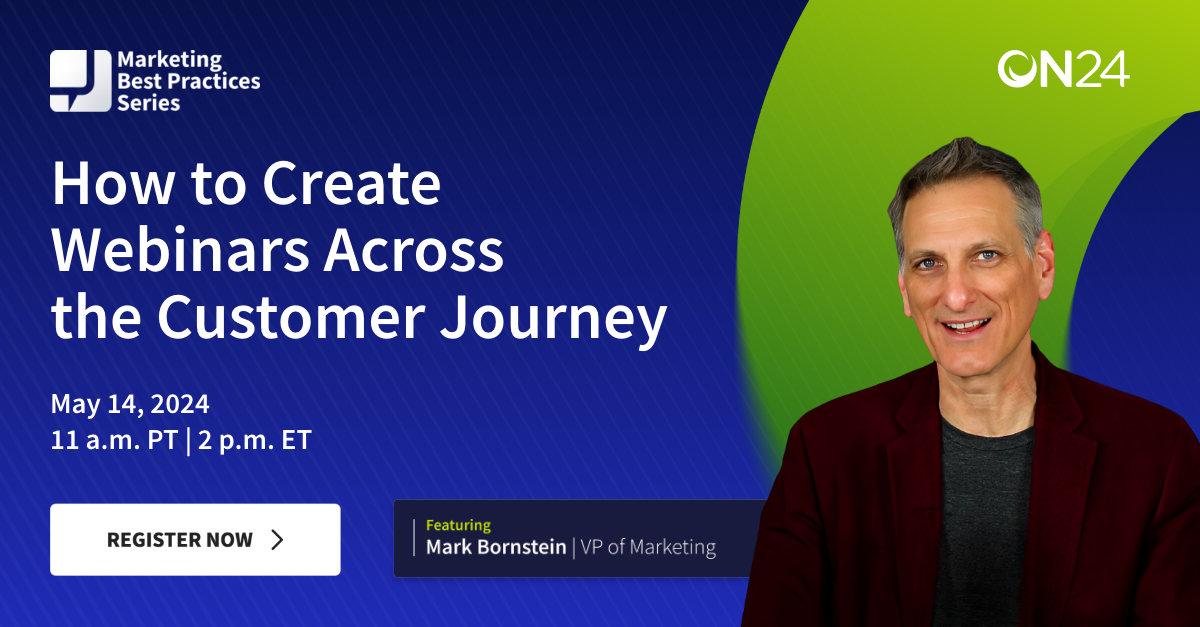Webinars are one of the best channels for generating, nurturing and converting leads, and often carry with them unique benefits compared to other types of digital marketing tactics.
But to get the most from webinars, you need to create a full webinar funnel that takes your audience on a journey. Get it right and you’ll build a bigger audience than ever and benefit from a higher conversion rate.
Here’s everything you need to know about webinar funnels, and actionable advice on how you can build your own.
What is a webinar funnel?

A webinar funnel is a digital sales funnel that uses webinars as the primary medium for acquiring, nurturing and converting leads. In other words, it’s a marketing method that uses webinars to attract audiences and nurture attendees into paying users, clients or customers.
Why are webinar funnels crucial for businesses?
Webinars are a great medium to build a sales funnel around because they’re so versatile. A single webinar can cover a lot of ground, allowing you to educate, entertain and even convert viewers in a single event.
That means they offer excellent ROI — capable of replacing an entire content funnel with far fewer assets.
The anatomy of an effective webinar funnel

A webinar funnel is just like any other marketing funnel. The only significant difference is that a webinar is at the center of each stage. For example, you’ll have webinars for generating awareness, webinars to accelerate buying journeys and drive consideration, and webinars designed to finally convert prospects into full-fledged customers.
Remember that no buying journey is purely linear; prospects can convert into customers at nearly any stage and often you’ll see customers attend events designed to generate awareness. And that’s okay! With the right CTAs, you can engage anyone at any stage of the journey from any webinar.
Like any other funnel, webinar marketing funnels involve multiple stages that guide users through the traditional buying journey. This journey is typically represented in three stages: awareness, consideration and conversion.
Here’s how a webinar funnel looks:
Awareness stage: drawing attention
The first stage in your webinar funnel is awareness. Webinars here are designed to get audiences interested in your brand, its perspective and the solutions you offer. Often, these digital experiences will engage audiences at a high level and popular topics and formats can include:
-
- Publishing a benchmarks or trends report
- Facilitating a panel discussion
- Sharing best practices
- Offering a course or certification

Audiences here are primarily interested in the information and perspectives you and any peers have to offer — not necessarily your brand. So, make sure your messages reflect that fact when you follow up with attendees. Instead of pitching your solution, try:
-
- Promoting your next webinar
- Introducing attendees to a unique offer, like a digital certification or course
- Offering additional content, like a follow-up blog post or related collateral
Consideration stage: engaging potential attendees
The consideration stage may be the most tricky of the three webinar marketing funnel stages. Somewhere between a demo and awareness, these webinars seek to both educate audiences and introduce your organization as a possible solution to an attendee’s problems.
Here, a narrower focus is essential. You’re not trying to generate brand awareness but rather leads that sales can actually follow up on. That means two things for you as a webinar marketer: First, your webinar should focus on a target audience; Second, it should be as engaging as possible.
Here’s why.
Focusing on a target audience allows you to tailor your webinar to their needs. For example, if your audience is in the life sciences sector, you can discuss industry-specific trends like regulations and continuing education and how your solution can complement both.
Consideration webinars should also engage your attendees. Polls, surveys, CTAs and Q&A should be strategically used throughout the webinar to understand audience pain points and answer attendee questions. Having a good webinar presenter, someone who will respond live on air to audience questions and compel attendees to respond to prompts, can help.
Audience engagement is absolutely essential for your webinar marketing efforts. Good engagement offers you more first-party data, which you can use to segment attendees and empower sales teams with enough context to seamlessly continue any conversation a prospect instigated.
Good webinars to run for this stage can include:
-
- Industry panels
- Industry trends reports
- Industry-related news
Conversion Stage: From Attendees to Customers
The final element of a webinar funnel, and arguably the most important, is converting attendees into customers. There are two main ways of achieving this: with CTAs and offers injected directly into the webinar and with post-event follow-ups.
The former is most effective if your desired conversion action has low objection rates – like a free trial for a SaaS product, for example.
The latter is a better fit for products with higher barriers to conversion, like expensive products or services, giving you a chance to personalize your approach and keep nurturing a lead who’s already warm.
Let your attendees choose their journey
Creating webinars targeting the awareness, consideration and conversion stages of the customer’s journey is a smart play for any marketing organization. But today’s buying journey isn’t linear — and your engagement touchpoints need to reflect that reality.
That’s why you should empower webinar attendees to choose their own buying journeys. That is, provide attendees with the opportunity to engage with consideration, awareness and conversion-level content through CTAs, downloadable resources and more. By providing this content, you can also gain better insights into an account and understand what they need to further their journey.
Common Webinar Funnel Mistakes

Webinar funnels, and webinar marketing, in general, aren’t foolproof. You can make several key mistakes in the setup and execution process, which can seriously impact its overall success. These are the main webinar mistakes to avoid.
1. Not understanding your audience
As is the case with any content-driven marketing campaign, the key to success is knowing your audience. To get the most from a webinar funnel, you need to make sure the webinar is actually useful and interesting to the people you’re targeting. Otherwise, you’ll struggle to build interest and keep people engaged, meaning you’ll get fewer attendees than is ideal.
2. Weak promotion strategies
A “If you build it, they will come” attitude doesn’t cut it if you’re trying to build an effective webinar funnel. You need to ensure your marketing at the top of the funnel is effective to build interest and guarantee a meaningful following or audience. This can include using all the different types of marketing channels available to you to attract users.
3. Neglecting post-webinar engagement
The end of your webinar shouldn’t be the end of your webinar funnel. Create plans to follow up with attendees to get the most value out of it. This post-webinar engagement is primarily an opportunity to continue to nurture leads and push them toward a conversion. But you can also use it to get feedback on your webinar content, helping you to make improvements for next time.
Optimizing the conversion path: from clicks to clients

Ultimately, for your webinar funnel to be successful, it needs to generate conversions. There are lots of factors that contribute to that metric, but these two steps will give you a big head-start.
Reveal buying intent with first-party data
Not all of your webinar attendees will be prime candidates for conversion. Some might just be there to get information, for example. Identifying attendees who have buying intent is particularly valuable in ensuring you’re focusing on the most valuable members of your audience.
First-party data, sourced from your CRM or website analytics platform, for instance, can help. You can use this information to identify attendees who have previously displayed buying intent, whether by signing up for a free trial, emailing a sales rep or something else.
You can prioritize them in your webinar marketing campaigns and post-webinar follow-up efforts when you’ve identified them.
Crafting compelling CTAs
The CTAs you use throughout your webinar funnel play a big role in generating your final results. All of the general best practices for writing CTAs apply in webinar funnels, too.
That includes being extremely clear about what’s on offer, writing concisely to avoid overwhelming the reader, and A/B testing design options to find the best converting CTA. But the key to getting the most from your webinar funnel CTAs is to use personalization wherever possible.
If you can segment your audience for your pre-webinar marketing campaigns and target each segment with uniquely relevant CTAs, you can drive much higher sign-up rates. Personalized CTAs in post-webinar engagement can also be effective at generating more conversions from the same number of follow-ups.
Strategies to attract the right audience

While any audience is better than none, your webinar will have a much higher chance of delivering tangible results if you focus on attracting the right audience. Here are two of the best ways to do that.
Target pain points and offer solutions
If you understand your target audience, you should know their specific pain points regarding the problem your product or service solves. Using this knowledge in your webinar funnel marketing can be a highly effective tool for driving more sign-ups.
Fundamentally, your audience doesn’t need a product or service; they need a solution. You can hook them quickly by clearly stating in your marketing assets that your webinar will address this need.
Leveraging Social Media and Paid Ads
As we mentioned earlier, a diverse mix of marketing channels is the best way to build an engaged audience for your webinar. But social media and paid advertising are two particularly effective channels as you build awareness.
Both offer access to a vast audience. But more importantly, they both offer effective granular audience targeting capabilities. That means you can tailor your campaigns to target your ideal customer profile based on demographics or interests, boosting your marketing results.
Engaging Your Audience in Each Stage of the Webinar Funnel

While each part of the webinar funnel process aims to achieve a different objective, they’re all fundamentally concerned with keeping your audience engaged. Here’s how you can maximize audience engagement before, during, and after your webinar.
Pre-Webinar Engagement: Building Anticipation
To maximize the number of attendees your webinar pulls in, you need to focus pre-webinar marketing and engagement on building anticipation and excitement. The content you use to engage with your audience in the awareness stage should be tailored to hook users by broadcasting the value your webinar will deliver.
You can also use other techniques, like announcing guests, offering special promotions for attendees, or creating a sense of exclusivity with an attendee cap to create more anticipation.
Just make sure to be clear in all of your marketing assets about when the webinar is taking place and how people can sign up for it, to ensure your audience can channel their excitement into an action.
During the Webinar: Holding Attention and Adding Value
The focus on keeping your audience engaged should remain a priority as you create your webinar content. Getting people to attend is one thing but keeping them engaged throughout the session requires some more effort.
Key techniques to maximize engagement during your webinar to ensure your audience maintains their attention include:
-
- Focusing your content on delivering real, actionable value
- Using plenty of visuals to complement text or speech
- Integrating interactive elements to encourage audience participation
- Appointing a webinar moderator to answer audience questions
Post-Webinar Actions: Nurturing and Converting Leads
As we mentioned earlier, not all of the conversions your webinar generates will come from during the webinar. Following up with attendees afterward provides a valuable opportunity to address any final objections and convert them into paying customers or users.
Take a highly personalized approach to ensure success in this part of the webinar funnel. Each attendee will have different needs and preferences. If you can learn what they are and form your follow-up conversation around them, you’ll have a better chance of converting the lead.
Tools and Platforms to Streamline Your Webinar Funnel

Choosing the right webinar hosting platform can dramatically increase how smoothly your webinar runs, and give you more options for engaging with your audience.
Choosing the Right Webinar Software
ON24 is a dedicated, all-in-one webinar solution that offers much more than a simple platform for hosting the event. A host of robust backend tools allows you to create more impactful webinars while maximizing your opportunities to convert leads. That includes:
-
- Conversion tools that allow your audience to self-serve
- AI-powered content generation
- A proprietary webinar analytics dashboard
- Built-in follow-up survey creator
- CRM and marketing automation platform integrations
- Automated speech-to-text captioning
This suite of tools and features makes building your webinar funnel easier. For example, you can pre-build conversion paths to integrate with your webinar content or get directly actionable insights from the analytics platform to prioritize your follow-up actions.
Measuring the Success of Your Webinar Funnel

Ensuring your webinar funnel is successful is the most important thing, but taking the time to measure your success can also be valuable. Here’s how you can make sure that you learn from every webinar funnel you deploy.
Key Metrics to Track
What webinar performance metrics you’re most interested in will depend on your specific objectives. But, generally speaking, it’s a good idea to track and analyze how your webinar funnel performed in the following key areas:
-
- Registrations: How many people you captured through awareness marketing, measured with the number of unique contact details collected.
-
- Attendance rate: What percentage of the people who signed up actually attended the webinar, measuring how effective your lead-up engagement was.
-
- Conversion rate: What percentage of your webinar attendees completed a conversion action during or after the webinar.
By analyzing your performance in these key metrics, you can better understand which areas of the webinar funnel you underperformed in. This makes it easier to improve your approach before planning your next webinar.
Iterating and Improving: Continuous Optimization

By consistently tracking the engagement metrics that apply to your funnel over the course of several separate webinar funnels, you can see how your performance is trending. An iterative approach to improving—learning from the data and making small tweaks that lead to better performance—works best over the long term.
You’ll gradually see improved results if you commit to iterating on your webinar funnel strategy. Every webinar campaign you execute will give you more insights to improve the next one, meaning you’ll eventually be confident that your webinar will be a success, even before you launch it.

